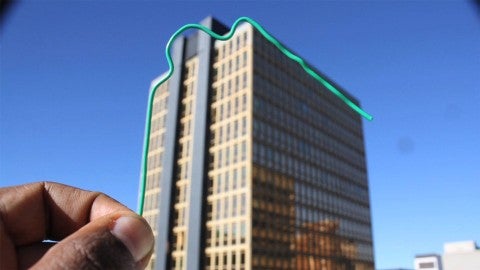Born in Addis Ababa and based in Brooklyn, artist Ezra Wube has long seen himself as having two homes and his art as a means to reconcile these two belongings. Through his multi-disciplinary practice of video, painting, photography, performance, animation, and installation, Wube can transcend limitations of time and distance to be present in multiple places or inhabit an in-between space, where, as the artist explains, he is “never fully part of the present or the past.”
Much of Wube’s art investigates mobility and movement, the malleability of time and place, and identity as an abstract experience. Past work includes videos that poetically and painstakingly convey such themes, including Amora (2009), an animated video of ink drawings on a window repeatedly washed away by water, and At the Same Moment (2013), a stop-action animation of scenes from Wube’s daily commute painted from memory on a single canvas. Both suggest the imprint of nonetheless fleeting life experiences.
Wube earned his BFA at Massachusetts College of Art in 2004 and his MFA at Hunter College in 2009. As a graduate student he trained as a painter; however, as he was wrapping up his studies, he explored a new medium that would transform his art. Wube explains, “I accidentally ran into stop action animation. It became a great way for me to do tons of paintings, layering one on top of another. I also wanted to make paintings that were alive with sounds and time, a static painting on canvas just wasn’t enough.” Animation became a solution to the immobility of his painted imagery. It is a way, a means, or a mela, the Amharic translation and title of his 2011 animated video.
In Mela, Wube shows a blurry 360-degree panoramic view of Johannesburg’s skyline, against which Wube inserts a paper clip in the foreground. As the camera rotates, he uncoils and continually reshapes clips to follow the outline of the tops of the buildings. The paper clips change color throughout the video, cycling through green, yellow, red, black, white, blue, and back to green—the colors of the South African flag. These various hues also are a reminder of the utopic idea of the “rainbow nation,” a term coined by Bishop Desmond Tutu and promulgated by Nelson Mandela in the 1990s. It was a concept developed in opposition to the strict Apartheid-era division of Black and white populations and suggests that the various cultures and ethnicities in South Africa could live in harmony. Just as “rainbowism” belies the legacy of racism and the social struggles that remain in contemporary South Africa, the lighthearted ease and tone of Mela obscures the onerousness of immigration, which inspired his incorporation of the clips. “The idea of using paper clips is: immigrants are already filling out so much paperwork, and the paperclip is a common part of that process, to bind all that together,” according to Wube.
In Mela, the artist repurposes this banal, inanimate object. He vivifies the clips and presents them on a larger-than-life scale, running across the skyline and over the city’s architecture. Similar to the immigrant experience, the clips have new purposes and adapt to different circumstances beyond fastening paper. As they explore Johannesburg, their movement evokes the search for belonging and the process of familiarizing oneself with a new cultural context. Wube portrays how one creates a connection to a place, literally and figuratively. We see his hands onscreen moving with the clips and guiding them along roofs, and his bodily presence alludes to his personal history and journey of creating a home in and between multiple locations. Wube's interpretation of his own experience nonetheless evokes those of countless people who leave their ethnic homelands, by choice or force, to find or create culture and community, and it exemplifies the way or mela, “through imagination, learning, and a continuous adjustment, [Wube strives] to relate the communal with the personal identity.” – Kanitra Fletcher

